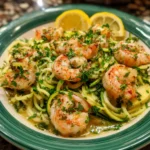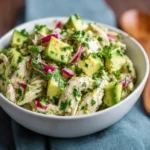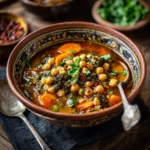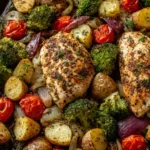Moroccan Chickpea Stew: A Hearty, Flavorful Journey Through North African Cuisine
Introduction
Moroccan Chickpea Stew, also known as Harira when in its traditional soup form or simply a spiced chickpea tagine, is a soul-warming dish that embodies the rich culinary heritage of Morocco. This vegetarian stew is celebrated for its deep, complex flavors, aromatic spices, and comforting textures. Often enjoyed during Ramadan to break the fast, it has become a staple across homes and markets throughout Morocco and beyond. Whether served with crusty bread or fluffy couscous, Moroccan Chickpea Stew offers a nourishing blend of legumes, vegetables, herbs, and warm spices that delight the senses and satisfy hunger with every spoonful.
This plant-based dish stands out not only for its delicious taste but also for its cultural significance and nutritional richness. It’s a celebration of simplicity meeting sophistication—where humble ingredients like chickpeas, tomatoes, and lentils are transformed into a luxurious meal through the artful use of Moroccan spice blends and slow cooking techniques. In this comprehensive guide, we’ll dive into the origins of the stew, explore its key components, provide a detailed step-by-step recipe, share expert tips, discuss health benefits, and offer variations so you can personalize it to your palate.
The History
The roots of Moroccan Chickpea Stew trace back centuries, embedded deeply in the culinary traditions of North Africa. While similar legume-based stews appear across the Mediterranean and Middle East, Morocco’s version is uniquely flavored by its Berber, Arab, Andalusian, and French influences. Historically, Moroccans have relied on legumes such as chickpeas and lentils as primary sources of protein, especially during religious observances like Ramadan and Lent when meat consumption was restricted.
Harira, one of the most iconic soups in Moroccan cuisine, often includes chickpeas and serves as both a starter and a main course. Traditionally prepared at sunset during Ramadan, families gather to break their fast with a bowl of Harira followed by dates and sweets. Over time, regional adaptations emerged—coastal areas incorporated more seafood, mountain villages used preserved lemons and olives, while desert communities added dried fruits for sweetness and energy.
Chickpeas themselves have been cultivated in North Africa since ancient times, valued for their ability to grow in arid climates and store well. The combination of chickpeas with tomatoes (introduced after contact with the Americas), onions, garlic, and spices like cumin, ginger, turmeric, and saffron created a flavor profile that defines much of Moroccan cooking. Today, Moroccan Chickpea Stew transcends religious and seasonal boundaries, appearing year-round on tables around the world thanks to its adaptability and wholesome appeal.
Ingredients Breakdown
The magic of Moroccan Chickpea Stew lies in its harmonious blend of fresh produce, pantry staples, and aromatic spices. Each ingredient plays a vital role in building layers of flavor, texture, and nutrition. Below is an in-depth look at the core components:
- Chickpeas: The star of the dish, chickpeas (garbanzo beans) provide a meaty texture and are packed with plant-based protein, fiber, iron, and folate. They can be used canned for convenience or soaked and cooked from dry for a more authentic, creamy result.
- Tomatoes: Fresh ripe tomatoes or high-quality canned crushed tomatoes form the base of the stew, lending natural acidity, sweetness, and body. Tomato paste enhances depth and color.
- Onions and Garlic: These aromatics build the foundational flavor. Yellow onions add sweetness when sautéed, while garlic brings pungency and warmth.
- Carrots and Celery: Commonly used in Moroccan mirepoix (sofrito), they contribute earthiness, subtle sweetness, and additional fiber.
- Lentils: Brown or green lentils are sometimes added to enrich the stew’s texture and boost protein content without overpowering the chickpeas.
- Olive Oil: Used generously for sautéing, extra virgin olive oil adds fruitiness and helps release fat-soluble compounds in the spices.
- Spices: A quintessential Moroccan spice blend includes ground cumin, ground coriander, ginger, turmeric, cinnamon, paprika (sweet or smoked), black pepper, and a pinch of saffron threads if available. Some versions include a touch of cayenne for heat.
- Fresh Herbs: Cilantro and flat-leaf parsley are essential for finishing the stew, adding brightness and freshness. Mint may also be used in certain regions.
- Lemon Juice: Adds a bright, citrusy contrast that balances the richness of the stew.
- Vegetable Broth or Water: Provides liquid for simmering; broth intensifies flavor, while water keeps it lighter.
- Couscous or Bread (optional): Served alongside for soaking up the flavorful sauce.
Step-by-Step Recipe
Now that you’re familiar with the ingredients and background, let’s walk through how to make a classic Moroccan Chickpea Stew right in your kitchen. This method yields about 6 servings and takes approximately 45 minutes to 1 hour, depending on whether you use pre-cooked or dried chickpeas.
Ingredients
- 2 tablespoons extra virgin olive oil
- 1 large yellow onion, finely chopped
- 3 cloves garlic, minced
- 2 medium carrots, diced
- 2 celery stalks, diced
- 1 large red bell pepper, chopped (optional)
- 1 ½ teaspoons ground cumin
- 1 ½ teaspoons ground coriander
- 1 teaspoon ground ginger
- 1 teaspoon sweet paprika
- ½ teaspoon ground turmeric
- ½ teaspoon ground cinnamon
- ¼ teaspoon cayenne pepper (optional, for heat)
- 1/8 teaspoon saffron threads, crumbled and soaked in 2 tbsp warm water (optional but recommended)
- 1 can (14 oz / 400g) diced tomatoes or 2 cups fresh chopped tomatoes
- 2 tablespoons tomato paste
- 1 ½ cups cooked brown or green lentils (or ½ cup dry, rinsed)
- 2 cans (15 oz / 425g each) chickpeas, drained and rinsed (or 3 cups home-cooked)
- 4 cups vegetable broth (low sodium preferred)
- Salt to taste (start with 1 tsp)
- Freshly ground black pepper to taste
- 1/3 cup chopped fresh cilantro
- 1/3 cup chopped fresh flat-leaf parsley
- Juice of 1 lemon
- Lemon wedges, for serving
- Cooked couscous, quinoa, or crusty bread, for serving
Directions
- Sauté the Aromatics: In a large heavy-bottomed pot or Dutch oven, heat the olive oil over medium heat. Add the chopped onion and a pinch of salt. Cook for 5–7 minutes, stirring occasionally, until softened and golden.
- Add Garlic and Vegetables: Stir in the garlic, carrots, celery, and red bell pepper (if using). Cook for another 5–7 minutes, allowing the vegetables to soften and release their fragrance.
- Bloom the Spices: Reduce the heat slightly and add all the ground spices—cumin, coriander, ginger, paprika, turmeric, cinnamon, cayenne (if using), and the saffron with its soaking water. Stir constantly for 1 minute to toast the spices and awaken their essential oils. Be careful not to burn them.
- Build the Base: Stir in the tomato paste and cook for 1–2 minutes until it darkens slightly and becomes fragrant. Then add the diced tomatoes (with juices) and stir well to combine.
- Add Liquids and Legumes: Pour in the vegetable broth. Add the cooked lentils and chickpeas. If using dry lentils instead of pre-cooked, add them now along with the broth—they will cook during the simmering process. Bring the mixture to a gentle boil.
- Simmer the Stew: Reduce the heat to low, cover partially, and let the stew simmer for 30–40 minutes. This allows the flavors to meld and the lentils (if raw) to become tender. Stir occasionally to prevent sticking. If the stew thickens too much, add a bit more broth or water.
- Season and Finish: Taste and adjust seasoning with salt and pepper. Stir in the chopped cilantro, parsley, and lemon juice. The acidity from the lemon brightens the entire dish and balances the warmth of the spices.
- Serve Warm: Ladle the stew into bowls. Serve hot with lemon wedges on the side and your choice of accompaniment—steamed couscous, whole wheat bread, or even quinoa for a protein-rich twist.
Tips
- Toast Your Spices Properly: Blooming spices in oil unlocks their full aroma. But watch carefully—spices burn quickly and turn bitter.
- Use Dry Chickpeas When Possible: Soaking and cooking dried chickpeas gives a creamier texture and better flavor absorption. Use a pressure cooker to reduce cooking time.
- Better Flavor with Time: Like many stews, Moroccan Chickpea Stew tastes even better the next day after the flavors have fully integrated. Reheat gently on the stove.
- Adjust Consistency: Prefer a soup-like consistency? Add more broth or water. Want it thicker? Simmer uncovered longer or mash some chickpeas against the side of the pot.
- Acidity is Key: Don’t skip the lemon juice—it lifts the heaviness of the stew and makes the spices pop.
- Fresh Herbs Matter: Dried herbs won’t deliver the same vibrancy. Add them at the end to preserve their freshness.
- Freeze for Later: This stew freezes beautifully. Store in airtight containers for up to 3 months.
- Slow Cooker Option: After sautéing the base, transfer everything to a slow cooker and cook on low for 6–8 hours or high for 3–4 hours.
Variations and Customizations
One of the greatest strengths of Moroccan Chickpea Stew is its versatility. Here are several ways to customize it based on dietary preferences, seasonal availability, or regional inspiration:
- With Meat: For non-vegetarian versions, add cubed lamb, beef, or chicken during the sauté phase. Brown the meat before adding onions for richer flavor.
- Smoky Twist: Add smoked paprika or a small piece of grilled roasted red pepper blended into the base for a deeper, smokier note.
- Dried Fruit Addition: Stir in raisins, apricots, or prunes during the last 10 minutes of cooking for a sweet contrast—a common trait in Moroccan tagines.
- Nutty Crunch: Top with toasted almonds or pine nuts before serving for added texture.
- Preserved Lemon: Finely chop 1–2 tablespoons of preserved lemon rind and stir in at the end for a tangy, umami punch.
- Creamy Version: Blend half the stew and mix it back in for a silkier texture, or swirl in a spoonful of plain yogurt or coconut milk.
- Gluten-Free: Naturally gluten-free! Just ensure your broth and spices are certified GF.
- Vegan & Oil-Free: Skip the olive oil and sauté in water or broth. Use coconut aminos or miso for depth if needed.
- Instant Pot Method: Use Sauté mode for steps 1–3, then pressure cook on High for 15 minutes (for canned chickpeas) or 35 minutes (for dry chickpeas + lentils). Quick release and finish with herbs and lemon.
- Spice Level: Control the heat with cayenne or fresh chili. Harissa paste (1–2 tsp) stirred in at the end adds North African fire.
Health Considerations and Nutritional Value
Moroccan Chickpea Stew isn’t just delicious—it’s a powerhouse of nutrition ideal for those seeking plant-based meals rich in fiber, protein, and antioxidants. Here’s a breakdown of its health benefits:
- High in Plant-Based Protein: Chickpeas and lentils together provide about 15–20 grams of protein per serving, making this stew excellent for vegetarians and vegans.
- Dietary Fiber: With over 10 grams of fiber per bowl, this stew supports digestive health, stabilizes blood sugar levels, and promotes satiety—great for weight management.
- Heart-Healthy Fats: Olive oil contributes monounsaturated fats, which help lower bad cholesterol (LDL) and reduce cardiovascular risk.
- Rich in Vitamins and Minerals: Carrots supply beta-carotene (vitamin A), tomatoes offer vitamin C and lycopene (an antioxidant), while chickpeas are loaded with iron, magnesium, potassium, and B vitamins like folate.
- Anti-Inflammatory Properties: Turmeric contains curcumin, a compound known for its anti-inflammatory and antioxidant effects. Pairing it with black pepper enhances absorption.
- Low Glycemic Index: Thanks to its legume base and fiber content, this stew causes a gradual rise in blood glucose, making it suitable for diabetics when portion-controlled.
- Supports Gut Health: The combination of soluble and insoluble fiber feeds beneficial gut bacteria and improves microbiome diversity.
- Low in Saturated Fat and Cholesterol-Free: As a plant-forward dish, it naturally avoids animal fats and cholesterol.
Nutritional Estimate (per serving, approx. 1.5 cups):
- Calories: ~300–350
- Protein: 14–18g
- Fat: 9–12g (mostly unsaturated)
- Carbohydrates: 50–55g
- Fiber: 10–12g
- Sodium: 600–800mg (lower if using low-sodium broth)
- Vitamins: High in A, C, K, Folate
- Minerals: Iron, Potassium, Magnesium, Phosphorus
FAQ
Can I make Moroccan Chickpea Stew without lentils?
Yes, absolutely. While lentils add heartiness and extra protein, you can omit them and increase the amount of chickpeas for a simpler version.
How long does it keep in the fridge?
Stored in an airtight container, the stew will last 4–5 days in the refrigerator. Reheat on the stove with a splash of water or broth.
Can I freeze this stew?
Yes, it freezes very well. Cool completely, then store in freezer-safe containers for up to 3 months. Thaw overnight in the fridge before reheating.
Is this stew spicy?
Not inherently. The spices used are warm and aromatic rather than hot. However, you can control the heat level by adjusting cayenne or adding harissa.
What can I serve with Moroccan Chickpea Stew?
Traditional pairings include steamed couscous, crusty bread (like khobz), flatbreads, or quinoa. A side salad of cucumber-tomato with lemon dressing complements it perfectly.
Can I use other beans instead of chickpeas?
While chickpeas are traditional, you can substitute with cannellini beans, kidney beans, or butter beans. Keep in mind that flavor and texture will vary slightly.
Why is my stew too thick or too thin?
If too thick, add more broth or water. If too thin, simmer uncovered for 10–15 minutes to reduce, or mash some chickpeas to thicken naturally.
Can I make this oil-free?
Yes. Sauté the vegetables in water, vegetable broth, or use a non-stick pan. The stew will still be flavorful, though slightly less rich.
Summary
Moroccan Chickpea Stew is a vibrant, nutrient-dense dish that combines tender legumes, aromatic spices, and fresh vegetables into a comforting meal rooted in centuries of culinary tradition. Easy to customize and perfect for meal prep, it satisfies both the palate and the body with every bite.










